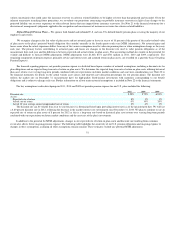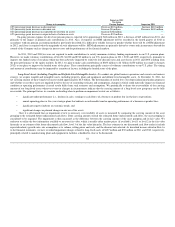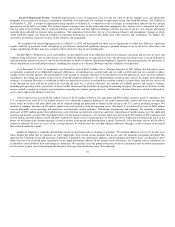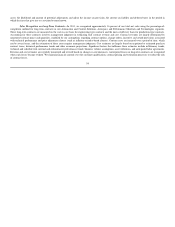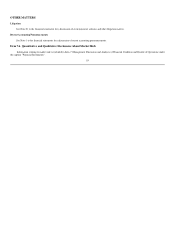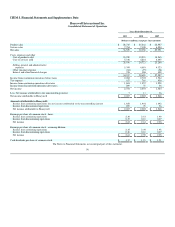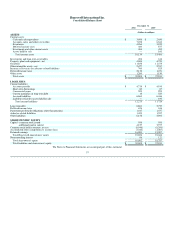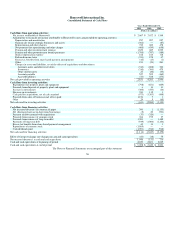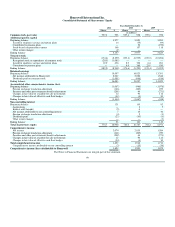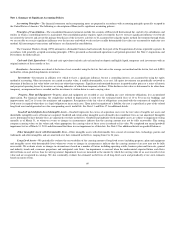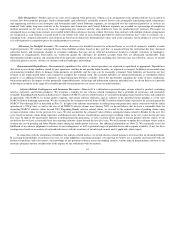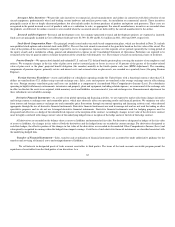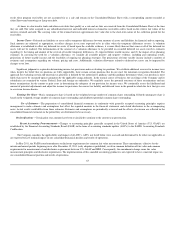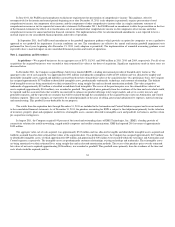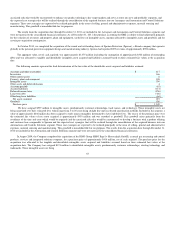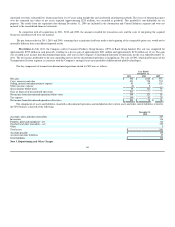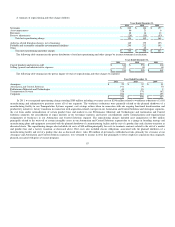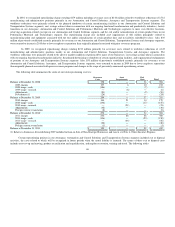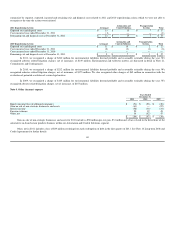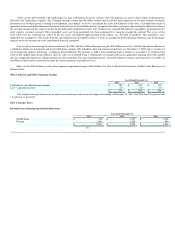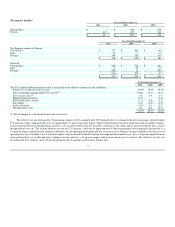Honeywell 2011 Annual Report Download - page 64
Download and view the complete annual report
Please find page 64 of the 2011 Honeywell annual report below. You can navigate through the pages in the report by either clicking on the pages listed below, or by using the keyword search tool below to find specific information within the annual report.
Sales Recognition—Product and service sales are recognized when persuasive evidence of an arrangement exists, product delivery has occurred or
services have been rendered, pricing is fixed or determinable, and collection is reasonably assured. Service sales, principally representing repair, maintenance
and engineering activities in our Aerospace and Automation and Control Solutions segments, are recognized over the contractual period or as services are
rendered. Sales under long-term contracts in the Aerospace and Automation and Control Solutions segments are recorded on a percentage-of-completion
method measured on the cost-to-cost basis for engineering-type contracts and the units-of-delivery basis for production-type contracts. Provisions for
anticipated losses on long-term contracts are recorded in full when such losses become evident. Revenues from contracts with multiple element arrangements
are recognized as each element is earned based on the relative fair value of each element provided the delivered elements have value to customers on a
standalone basis. Amounts allocated to each element are based on its objectively determined fair value, such as the sales price for the product or service when
it is sold separately or competitor prices for similar products or services.
Allowance for Doubtful Accounts—We maintain allowances for doubtful accounts for estimated losses as a result of customer's inability to make
required payments. We estimate anticipated losses from doubtful accounts based on days past due, as measured from the contractual due date, historical
collection history and incorporate changes in economic conditions that may not be reflected in historical trends for example, customers in bankruptcy,
liquidation or reorganization. Receivables are written-off against the allowance for doubtful accounts when they are determined uncollectible. Such
determination includes analysis and consideration of the particular conditions of the account, including time intervals since last collection, success of outside
collection agencies activity, solvency of customer and any bankruptcy proceedings.
Environmental Expenditures—Environmental expenditures that relate to current operations are expensed or capitalized as appropriate. Expenditures
that relate to an existing condition caused by past operations, and that do not provide future benefits, are expensed as incurred. Liabilities are recorded when
environmental remedial efforts or damage claim payments are probable and the costs can be reasonably estimated. Such liabilities are based on our best
estimate of the undiscounted future costs required to complete the remedial work. The recorded liabilities are adjusted periodically as remediation efforts
progress or as additional technical, regulatory or legal information becomes available. Given the uncertainties regarding the status of laws, regulations,
enforcement policies, the impact of other potentially responsible parties, technology and information related to individual sites, we do not believe it is possible
to develop an estimate of the range of reasonably possible environmental loss in excess of our recorded liabilities.
Asbestos Related Contingencies and Insurance Recoveries—Honeywell is a defendant in personal injury actions related to products containing
asbestos (refractory and friction products). We recognize a liability for any asbestos related contingency that is probable of occurrence and reasonably
estimable. Regarding North American Refractories Company (NARCO) asbestos related claims, we accrued for pending claims based on terms and conditions
in agreements with NARCO, its former parent company, and certain asbestos claimants, and an estimate of the unsettled claims pending as of the time
NARCO filed for bankruptcy protection. We also accrued for the estimated value of future NARCO asbestos related claims expected to be asserted against the
NARCO Trust through 2018 as described in Note 21. In light of the inherent uncertainties in making long term projections and in connection with the initial
operation of a 524(g) trust, as well as the stay of all NARCO asbestos claims since January 2002, we do not believe that we have a reasonable basis for
estimating NARCO asbestos claims beyond 2018. Regarding Bendix asbestos related claims, we accrued for the estimated value of pending claims using
average resolution values for the previous five years. We also accrued for the estimated value of future anticipated claims related to Bendix for the next five
years based on historic claims filing experience and dismissal rates, disease classifications, and average resolution values in the tort system for the previous
five years. In light of the uncertainties inherent in making long-term projections, as well as certain factors unique to friction product asbestos claims, we do
not believe that we have a reasonable basis for estimating asbestos claims beyond the next five years. We will continue to update the resolution values used to
estimate the cost of pending and future Bendix claims during the fourth quarter each year. For additional information see Note 21. We continually assess the
likelihood of any adverse judgments or outcomes to our contingencies, as well as potential ranges of probable losses and recognize a liability, if any, for these
contingencies based on an analysis of each individual issue with the assistance of outside legal counsel and, if applicable, other experts.
In connection with the recognition of liabilities for asbestos related matters, we record asbestos related insurance recoveries that are deemed probable.
In assessing the probability of insurance recovery, we make judgments concerning insurance coverage that we believe are reasonable and consistent with our
historical experience with our insurers, our knowledge of any pertinent solvency issues surrounding insurers, various judicial determinations relevant to our
insurance programs and our consideration of the impacts of any settlements with our insurers.
61


